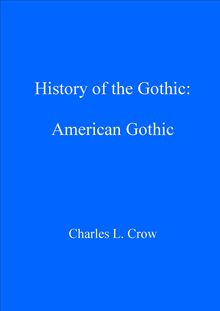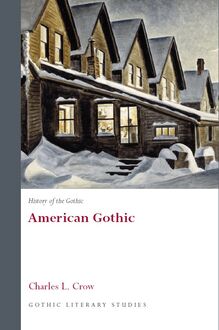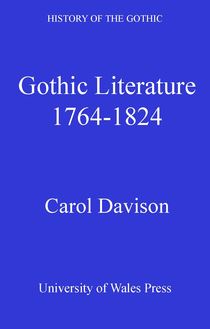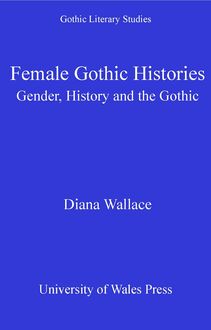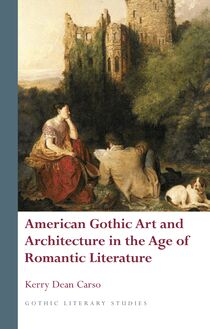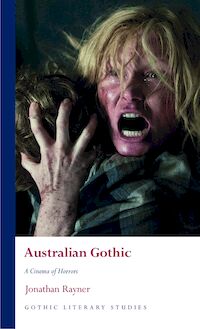Cornish Gothic, 1830-1913 , livre ebook
158
pages
English
Ebooks
2023
Vous pourrez modifier la taille du texte de cet ouvrage
Obtenez un accès à la bibliothèque pour le consulter en ligne En savoir plus
Découvre YouScribe en t'inscrivant gratuitement
Découvre YouScribe en t'inscrivant gratuitement
158
pages
English
Ebooks
2023
Vous pourrez modifier la taille du texte de cet ouvrage
Obtenez un accès à la bibliothèque pour le consulter en ligne En savoir plus
Publié par
Date de parution
15 juin 2023
Nombre de lectures
3
EAN13
9781786839930
Langue
English
This book asks why so many authors drew on Cornwall for inspiration across the long nineteenth century, and considers the seismic cultural changes in Cornwall that spurred this interest – from the collapse of the mining industry to the developing national rail network; from the birth of tourism to the neomedieval rise in interest in King Arthur. Understanding frequently overlooked Cornwall in this period is vital to understanding Gothic literature, the Victorian imagination, intellectual and creative networks, and attitudes towards regionality. The first part of the book considers landscape and legend, defining a mining Gothic tradition, exposing the shipwreck as Gothic mastertrope, and demonstrating how antiquarians drew from Cornish legends and lore. The second part explores encounters with modernity, investigating the impact of railway expansion on access to Cornwall, the development of a Cornish King Arthur as a key figure of Victorian masculinity, and the specific features of the Cornish ghost story.
Introduction: Corpses, Coasts and Carriages
Cornwall: A Brief Introduction
The Cornish Gothic
The Regional Gothic
Cornish Gothic Criticism
Part One - Landscapes and Legends: Preserving and Confronting the Past
Chapter One: ‘The dead lay buried and yet unburied’: Minescapes and the Subterranean World
The Subterranean Gothic
Wheal Darkness by H. D. Lowry
Chapter Two: ‘If there’s got to be wrecks, please send them to we’: Seascapes and Shipwrecks
Shipwreck as Gothic Master Trope
The Dead Secret and Wreck Media
Bram Stoker and ‘The Coming of Abel Behenna’
Chapter Three: ‘Hear the most curious stories’: Folklore, Antiquarianism and Gothic Rewritings
In the Roar of the Sea by Sabine Baring-Gould
Part Two – Travel and Tourism: Cornish Identity and Encounters with Modernity
Chapter Four: 'Out of the sound of the railway whistle': Gothic Travel and the Expansion of the Railway
Victorian Gothic Travel
Victorian Travel in Cornwall
The Jewel of Seven Stars and Gothic Travel into Cornwall
‘Colonel Benyon’s Entanglement’
Chapter Five: ‘The poet gives all his votes to us’: King Arthur and Arthurian Tourism in Tintagel
Nineteenth-Century Medievalism
Arthur in Cornwall
Case Studies
Chapter Six: ‘A phantom to proclaim their hoary and solitary age’: Cornish Ghosts and Hauntings
Visiting Haunted Cornwall
Economic Spectres
Haunted Shores
Conclusion
Publié par
Date de parution
15 juin 2023
Nombre de lectures
3
EAN13
9781786839930
Langue
English
CORNISH GOTHIC, 1830–1913
SERIES PREFACE
Gothic Literary Studies is dedicated to publishing groundbreaking scholarship on Gothic in literature and film. The Gothic, which has been subjected to a variety of critical and theoretical approaches, is a form which plays an important role in our understanding of literary, intellectual and cultural histories. The series seeks to promote challenging and innovative approaches to Gothic which question any aspect of the Gothic tradition or perceived critical orthodoxy. Volumes in the series explore how issues such as gender, religion, nation and sexuality have shaped our view of the Gothic tradition. Both academically rigorous and informed by the latest developments in critical theory, the series provides an important focus for scholarly developments in Gothic studies, literary studies, cultural studies and critical theory. The series will be of interest to students of all levels and to scholars and teachers of the Gothic and literary and cultural histories.
SERIES EDITORS
Andrew Smith, University of Sheffield
Benjamin F. Fisher, University of Mississippi
EDITORIAL BOARD
Kent Ljungquist, Worcester Polytechnic Institute Massachusetts
Richard Fusco, St Joseph’s University, Philadelphia
David Punter, University of Bristol
Chris Baldick, University of London
Angela Wright, University of Sheffield
Jerrold E. Hogle, University of Arizona
For all titles in the Gothic Literary Studies series visit www.uwp.co.uk
Cornish Gothic, 1830–1913
Joan Passey
© Joan Passey, 2023
All rights reserved. No part of this book may be reproduced in any material form (including photocopying or storing it in any medium by electronic means and whether or not transiently or incidentally to some other use of this publication) without the written permission of the copyright owner except in accordance with the provisions of the Copyright, Designs and Patents Act. Applications for the copyright owner’s written permission to reproduce any part of this publication should be addressed to the University of Wales Press, University Registry, King Edward VII Avenue, Cardiff CF10 3NS.
www.uwp.co.uk
British Library Cataloguing-in-Publication Data
A catalogue record for this book is available from the British Library.
ISBN 978-1-78683-991-6
eISBN 978-1-78683-993-0
The right of Joan Passey to be identified as author of this work has been asserted in accordance with sections 77 and 79 of the Copyright, Designs and Patents Act 1988.
The publisher has no responsibility for the persistence or accuracy of URLs for any external or third-party internet websites referred to in this book, and does not guarantee that any content on such websites is, or will remain, accurate or appropriate.
Cover image: The submerged schooner Mildred off Gurnard’s Head, 1912. © National Maritime Museum, Greenwich, London (Gibson’s of Scilly Shipwreck Collection).
This monograph is dedicated to Frank Scott.
C ONTENTS
Acknowledgements
Introduction: Corpses, Coasts and Carriages
Cornwall: A Brief Introduction
The Cornish Gothic
The Regional Gothic
Cornish Gothic Criticism
Part I: Landscapes and Legends: Preserving and Confronting the Past
1 ‘The dead lay buried and yet unburied’: Minescapes and the Subterranean World
The Subterranean Gothic
Wheal Darkness by H. D. Lowry
2 ‘If there’s got to be wrecks, please send them to we’: Seascapes and Shipwrecks
Shipwreck as Gothic Master Trope
The Dead Secret and Wreck Media
Bram Stoker and ‘The Coming of Abel Behenna’
3 ‘Hear the most curious stories’: Folklore, Antiquarianism and Gothic Rewritings
In the Roar of the Sea by Sabine Baring-Gould
Part II: Travel and Tourism: Cornish Identity and Encounters with Modernity
4 ‘Out of the sound of the railway whistle’: Gothic Travel and the Expansion of the Railway
Victorian Gothic Travel
Victorian Travel in Cornwall
The Jewel of Seven Stars and Gothic Travel into Cornwall
‘Colonel Benyon’s Entanglement’
5 ‘The poet gives all his votes to us’: King Arthur and Arthurian Tourism in Tintagel
Nineteenth-Century Medievalism
Arthur in Cornwall
Alfred Tennyson’s Idylls of the King
Travel Writing
6 ‘A phantom to proclaim their hoary and solitary age’: Cornish Ghosts and Hauntings
Visiting Haunted Cornwall
Economic Spectres
Haunted Shores
Conclusion
Notes
Bibliography
A CKNOWLEDGEMENTS
This project would not have been possible without the expert supervision and support of Nick Groom, William Hughes, Andrew Smith and Jason Hall. I am grateful for the patience of my excellent editor, Sarah Lewis, and for the University of Wales Press team at large for their generosity. Thank you to the teachers and colleagues who have shown faith and given me opportunities and time. I have only had the space and resources to finish this book thanks to Siân Harris and Samantha Matthews. Thank you to my cohort for the inspiration and commiseration. I am grateful to my family and friends, and know that this would not have happened at all without Harry Cruse’s unwavering support. I am grateful, too, for the many collaborators, research centres, editors, librarians, curators and administrative and support professionals who have enabled every step of this journey with their expertise, collegiality, and kindness. Especially to Jimmy Packham, Emily Alder, Giulia Champion and the Haunted Shores Network, to Jonny Davidson and British Library Publishing, the Courtney Library and the Royal Cornwall Museum, the David MacGregor Library of the SS Great Britain, Rhian Rowson and Bristol Museum, the Bristol Doctoral College, the British Society for Literature and Science, the Oxford Centre for Life Writing, Edge Hill Centre for Nineteenth-Century Studies, Andy McInnes, Laura Eastlake, and Bob Nicholson. Thank you to the AHRC/BBC New Generation Thinkers programme and the producers who have provided support and motivation in these latter stages. This research was supported by the South, West and Wales Doctoral Training Partnership (AHRC), the Cornwall Heritage Trust, the Q Fund, and the Edge Hill University Nineteen Wilkie Collins Fellowship.
Introduction Corpses, Coasts and Carriages
Robert Louis Stevenson in Across the Plains (1862) recalls the uncanny experience of meeting with Cornish miners abroad:
A knot of Cornish miners who kept grimly by themselves … discussing privately the secrets of their old-world, mysterious race. Lady Hester Stanhope believed she could make something great of the Cornish; for my part, I can make nothing of them at all. A division of races, older and more original than that of Babel, keeps this close, esoteric family apart from neighbouring Englishmen. Not even a Red Indian seems more foreign in my eyes. This is one of the lessons of travel – that some of the strangest races dwell next door to you at home. 1
Stevenson’s passage summarises the popular perception of Cornwall as a barbarous space in the wider British imaginary in the nineteenth century. At this time, the Cornish were perceived as ‘a mysterious race’, distinct from the surrounding English race (and seemingly from Stevenson’s Scottish kin) – they are separate geographically, culturally and historically. Despite Cornwall being an English county, the Cornish are explicitly ‘apart from neighbouring Englishmen’. They are proximal or adjacent to England, but not English. Instead, they are foreign, divided. Their difference is exaggerated by their ancientness, as they are both ‘old-world’ and ‘older’ than ‘Babel’. This ancientness, however, is not elevated – it reinforces the primitivity of the Cornish and upholds their otherness and insularity. The Cornish here are miners forced from their homes by radical economic decline, fighting to preserve their strangeness ‘across the plains’ in the construction of a global Cornish diaspora. This goes some way to explaining why the Cornish jealously guard their culture, while half a world stands between them and their homeland. Stevenson’s observations encapsulate the recurrent association of the Cornish with other seemingly old and ‘threatening’ peoples – ‘Red Indians’, Celts and Phoenicians. Furthermore, Stevenson gestures to one of the central tenets of the mid-nineteenth-century British Gothic – the domestic Gothic, or the return of the Gothic to the homestead, where ‘the strangest races dwell next door’. The nineteenth century saw the Gothic turn inwards, away from Ann Radcliffe’s and Horace Walpole’s Mediterranean climes, where ‘the wild landscapes of Romantic individualism give way to terrors and horrors that are much closer to home’. 2 While earlier Gothic authors, such as Clara Reeve, set Gothic tales in England, nineteenth-century British Gothic writing demonstrated a particular preoccupation with domestic fiction as encapsulating national anxieties in an increasingly globalised world.
Gothic fiction set in Cornwall in the nineteenth century relied on Cornwall’s simultaneous differences from and proximity to England – its Englishness and its not-Englishness – to provide a sense of the uncanny threat of the foreigner closer to home than initially believed, or within the home all along. 3 Stevenson’s reference to ‘Babel’ highlights specific anxieties surrounding the death of the Cornish language in the eighteenth century, often used to exaggerate Cornwall’s particularity from other Celtic nations and English regions. Cornwall here is shown to embody the re-emergence of an ancient past; a puncturing of Gothic histories – or ‘vestigial anachronisms’ – through to the present, where travelling to the Land’s End is an act of travelling into the past to encounter its ancient races. 4 This impression of Cornwall continued into the twentieth century, with S. P. B. Mais claiming in 1929 that ‘[a]t one moment you are in comfortable Devon … the next you are on strange soil, suddenly thrown back five thousand years’. 5 This movement of the traveller passing through time as well as space ‘


